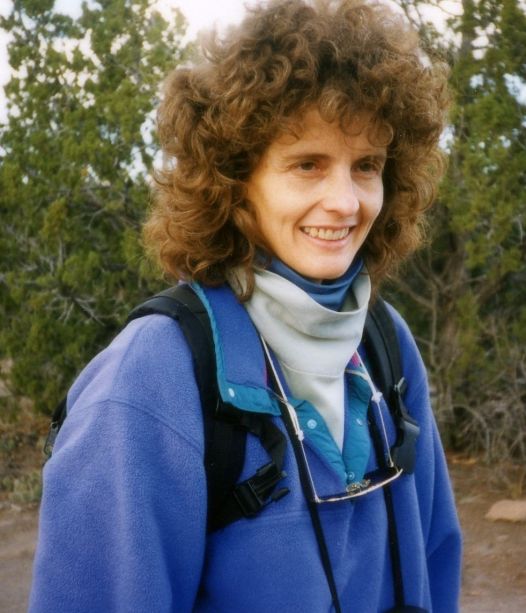
.
MD The Johns Hopkins University School of Medicine 1991
Residency at the Children’s National Medical Center (Washington DC) and Dartmouth School of Medicine’s Hitchcock Hospital. Further post-residency courses at Harvard Medical School.
PhD Princeton University 1985
Population Biology, Ecology, and Evolutionary Biology
MA Princeton University 1981
Behavioral Ecology
BA Yale University 1977
Biology (cum laude). Nina attended Yale as a National Merit Scholar.
…..Milton Academy & New Canaan Country School
Graduate of both
…
.
Nina was born at an early age (shortly before this picture was taken). She grew up in Darien, Connecticut, the youngest of five and pick of the litter.
.

.
Her mom (Edie), a Vassar & Columbia Teachers College graduate, was an enthusiastic journalist, unconventional mom, and (strict) high school English teacher. Her dad (John), a Harvard man decorated in WW2 (Tenth Mountain Division), supported the family in a career he pretty much despised. Manhattan businessman.
When the kids were grown and gone, John & Edie sold their home and headed west to the charms and ski slopes of Santa Fe. It was here that I (Nina’s husband, Calvin) first met them.
In the shadow of the Sangre de Cristos, Edie went toe-to-toe against developers who dared squander precious water. (Nina is very much like her mother!) The City of Santa Fe honored Edie’s efforts by declaring her a Living Treasure. (I began referring to her thereafter as a National Monument.)
.

Nina with her parents in New Mexico
.
As a child, Nina read a lot, wore funny glasses, dressed her cats in costumes, swam, sailed, loved math (she was a natural), and ate chocolate.
.
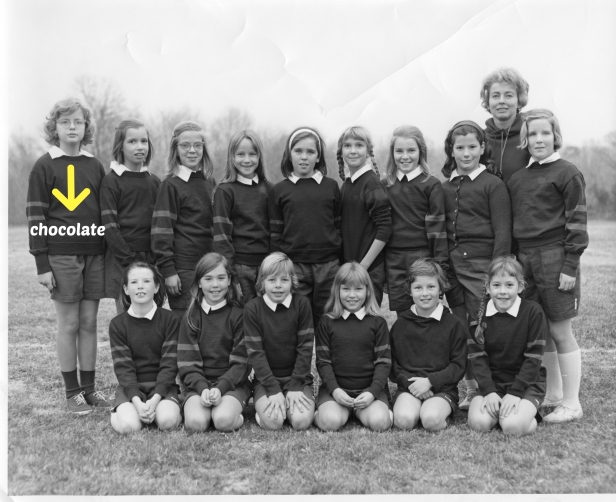
New Canaan Country Day School
.
She was a sweet child. (Still sweet, as a woman.) And tall. (Chocolate makes you tall and sweet. Remember this.)
At Yale, Nina found her true love. Birds. Bird-watching became her passion. (Why she would marry a man who could barely tell a duck from a chicken is beyond me.)
Decompressing from the Yale pressure-cooker, she spent several years post-graduation studying birds in the Florida Everglades and New England coast & marshes. Pinching pennies and dining on fresh-caught bluefish, she lived a bohemian life and loved every minute of it.
Her dream was wildness. No one was surprised when she enrolled in Princeton’s PhD program in Ecology/Evolutionary Biology/Population Biology and was soon studying tropical bird behavior (called Behavioral Ecology) with John Terborgh’s group in the Peruvian rainforest’s Manu National Park — a sprawling wilderness the size of Connecticut.
.

Manu National Park, Peru
.
Simply getting there was an act of faith — the hair-raising ride in the (open) back of a truck to the cloud-wreathed ridge of the Andes, then the vertiginous plunge down the other side on a twisty, single-lane dirt road that habitually washed out in heavy rains. All without guard rails.

Manu National Park (courtesy of Cocha Cashu website)
Arriving at the last outpost of modern civilization, the group loaded their gear into dugout canoes and vanished into the jungle — a place where mankind was a rare species. Several days of travel along shallow, braided tributaries of the Amazon brought them to a thatched hut in a small clearing on the bank of an oxbow lake. The Cocha Cashu field station.
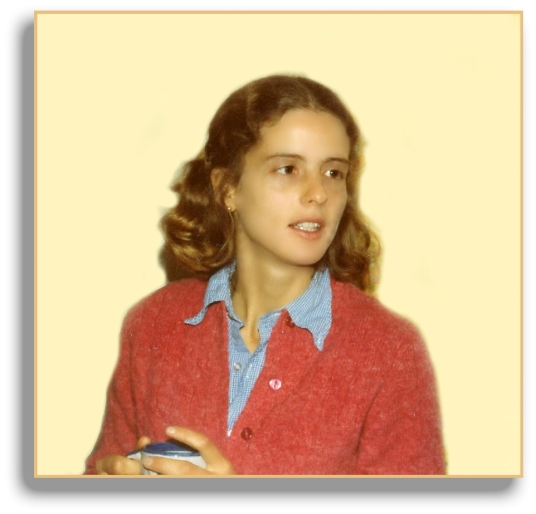
The youthful Amazonian researcher
.
Nina would live here in a tent for months at a time, totaling 2 years, with a handful of Princeton grad students and one or two faculty.
.
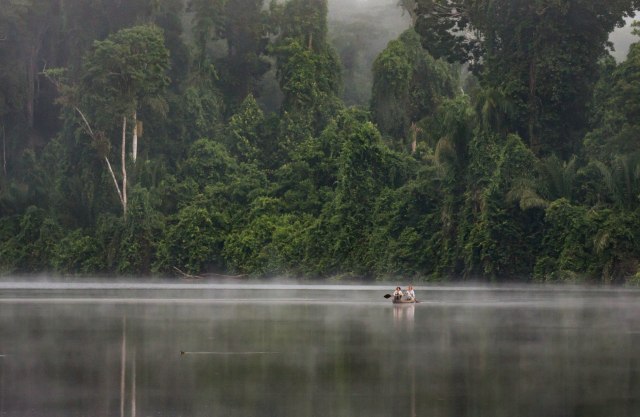
Biologists following giant otters on the Cocha Cashu oxbow lake (photo by Christine Paige)
.
Days were spent mist-netting and radio-tracking tropical birds, following trails traveled by jaguars, ocelots, peccaries, giant sloths, bushmasters — trails dangled over by boa constrictors — while troops of monkeys raced through the canopy, hurling simian commentary and feces at human cousins below.
.
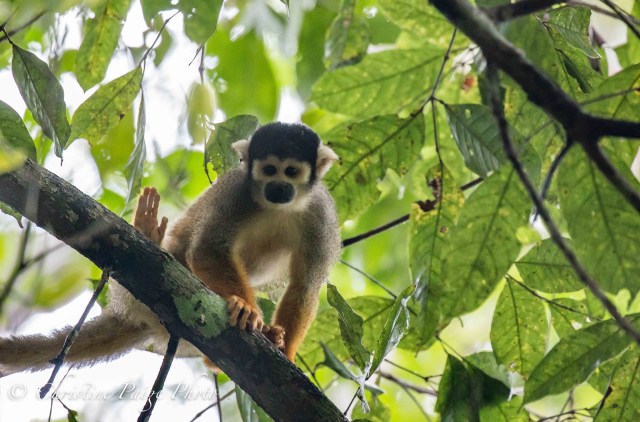
Bolivian black-capped squirrel monkey, Cocha Cashu (photo by Christine Paige)
.
Firearms were forbidden by the Peruvian govt. One had to live or die by the law of the jungle.
Then there were the visitors. Stone Age tribesmen who would materialize out of the bush, simply watch or signal their interest in metal objects or food, then melt back into the foliage. Breech-clouted hunters carrying blowguns & poison-tipped arrows. Always courteous, mysterious, curious. The following is from one of Nina’s letters home.
Do you remember my telling you about the 3 women who live across the river from us? No one has ever been able to talk to them, because they speak a language different from all the other tribes around here. Earlier this summer some Piro Indians living in a town on the Alto Madre (that we pass each year) discovered some wild Indians living across the river from them. They raided their camp and kidnapped a man whom they were surprised to be able to understand when he pled, “Don’t kill me! Don’t kill me!” They took him back to their town, fed him and gave him masato (yucca beer) and discovered that the oldest members of their tribe could understand his speech.
Just last week the Catholic padre from Shintuya came up here with this man, who speaks the same language as the women, an archaic form of Piro. It turns out the women have husbands and a small group back in the woods on the other side [of the oxbow lake], who are too afraid to come out in the open, it being the custom in tribal warfare here to kill the men but not the women. Even more surprising is that there is a third group of these people living behind us, somewhere to the north.
People here have in past years seen old overgrown cultivated farm plots and hunting trails — twigs all broken in one direction — when they’ve gone north towards the hill country at the edge of the floodplain. The padre plans to contact them soon — more of an anthropological hobby than for religious reasons, as the Catholics don’t proselytize.
It would be bad for the field station if these people lost their fear of us, because they could come in here and kill our tame animals, particularly the monkeys [which they eat].
It’s eerie to realize the woods are not as empty as we thought.

This is what the field station looks like now, many decades later. Much fancier! (Drawing by Jim Jourdane)
.
After writing up the day’s field notes, Nina would bathe in the oxbow lake, home to black caimen (alligators), packs of 6-foot-long otters left over from the Pleistocene, and piranha — along with huge, fruit-eating, delicious fish which she and her colleagues caught for dinner. (Before diving off the “swimming log” for the evening swim it was prudent to scan the surface with a headlamp for pairs of small glowing embers — the telltale orange eyeshine of waiting caiman. As bats zigzagged overhead.)
.
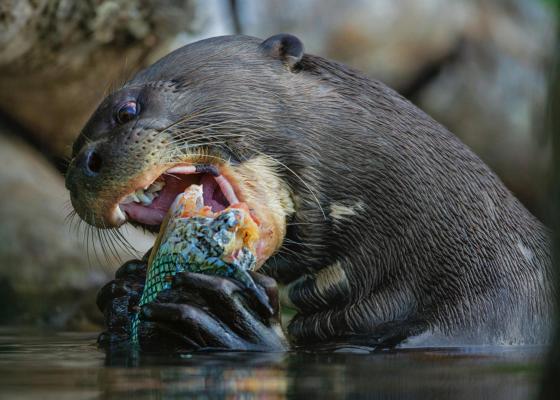
Giant Amazon Otter
.
She was never harmed.
Torrential rains occasionally flooded the site and every spider, termite, and other “creepy crawly” imaginable came floating by. Meanwhile, in the thatch-roofed commisary an emerald boa quietly made itself at home.
.
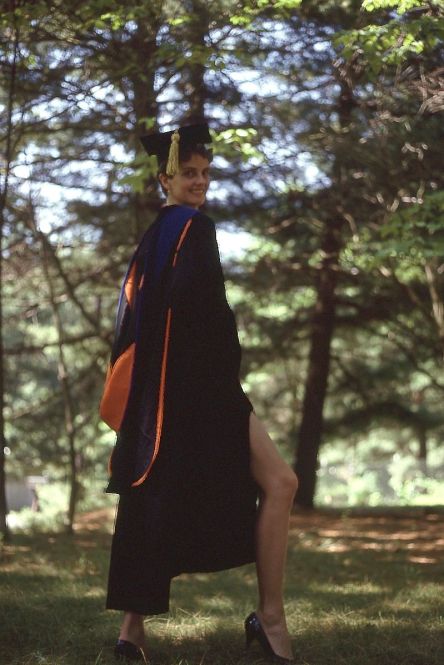
Newly-minted Princeton PhD
.
I met this playful, intrepid woman at the end of her Amazon sojourn as she was wrapping up her PhD, 30 years ago.
After Princeton, Nina did a year-long post-doc at the American Museum of Natural History (NY City). Here she realized that studying bird behavior in the jungle was one thing; examining their embalmed tiny bodies in a laboratory in NYC was another.
.

Camping in the Adirondack Park
.
Nina’s response was “medical school.” (The bridge from graduate school to medical school lies in the word “behavioral” — from wildlife behavior to human behavior. It makes sense that she became a pediatrician, since children are as near as we get to wild creatures — the ancestors and kinsmen of us all.)
.
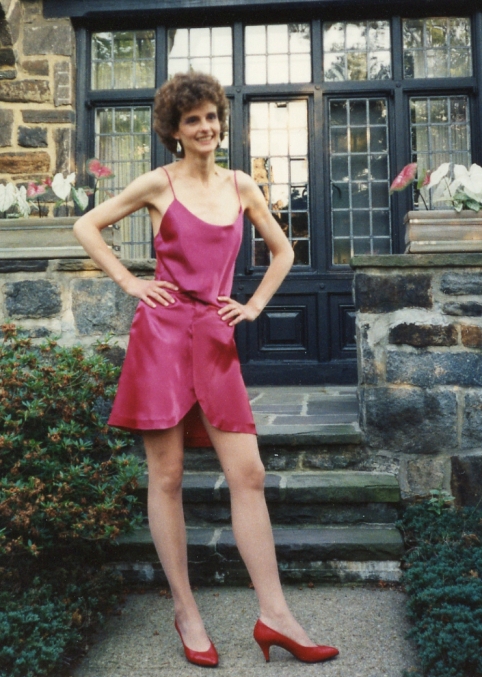
Brand new medical doctor
.
The big event in medical school was a summer sub-internship on the Navajo reservation. First at Sage Memorial Hospital in Ganado, then the Indian Health Service hospital in Shiprock. The experience was transformative for both of us.
.
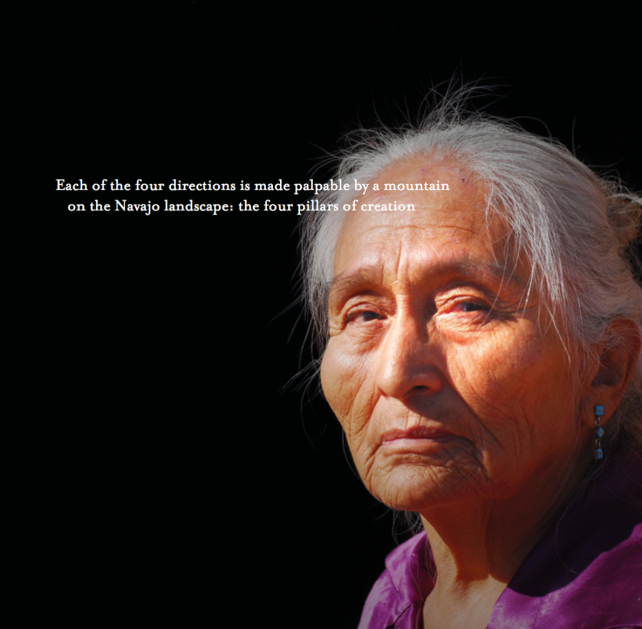
.
In this immense, potent landscape she delivered Navajo babies and treated elderly Navajo men and women who arrived at the hospital resplendent in silver & turquoise jewelry. (The jewelry is spiritually powerful. “Good medicine.”)
.

.
She did her internship year at the Children’s National Medical Center in Washington, DC, and the following two years of residency at the Dartmouth School of Medicine’s Hitchcock Hospital NH. (She switched to Dartmouth because she wanted to focus on rural medicine — and I detested Washington.)
Then, this:
.
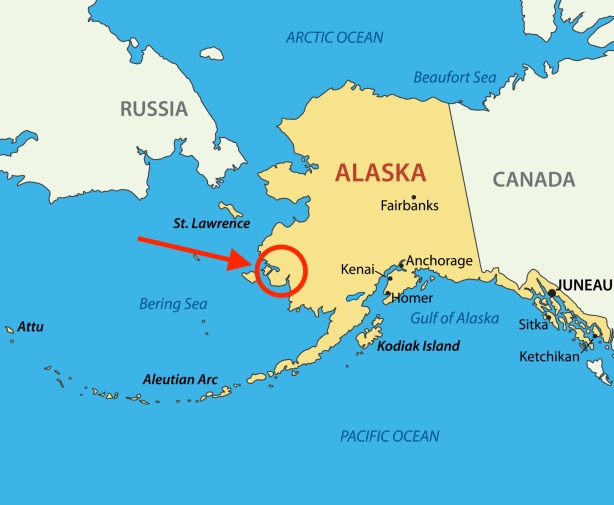
.
Southwest Alaska. Eighty miles up the Kuskokwim River from the Bering Sea. Just below the Yukon River. Four hundred fifty miles by jet from Anchorage over the Alaska Range (no roads beyond Anchorage). With Yup’ik Eskimos.
Tundra. A vast bog overlaying a permafrost of mud, sand, and water.
.

.
This girl was one of her patients. She lived on the edge of the Bering Sea in the Eskimo village of Toksook Bay.
.

.
.
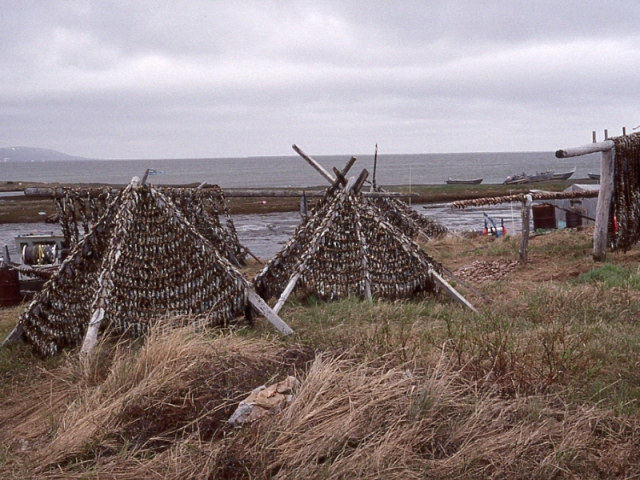
Herring-drying racks in Toksook Bay. Bering Sea in the background.
.
For two years Nina was a pediatrician at a native-run hospital whose docs covered an area the size of the State of Oregon. (Alaska is bigger than you imagine, as this hilarious song by Michael Faubion implies.)
.

Nina was Chief of Pediatrics in her second year at this hospital
.
She & I would take bush planes out to Eskimo villages for a week at a time, camping out in the ramshackle clinic building where Nina was the doc for those 7 days. (There are no restaurants or public accommodations in Eskimo villages. Their villages, often consisting of one to two dozen rudimentary wooden homes, are private, not open to visitors or the public except by invitation.)
.We lived in the muddy, rutted frontier town of Bethel, established nearly a century earlier by Moravian missionaries as a beacon of righteousness in this vast hinterland of satanic depravity, so went the argument.
.

Tununak, AK
.
Here among alder thickets and myriad ponds bordering the crumbling banks of the salmon-rich Kuskokwim — the Gift — the cross of Jesus was erected as a counter-Gift. Upon this alcohol-soaked, suicide-stained spot the well-meaning (Are they not?) agencies of western civilization have been systematically, methodically dismantling the delicate and altogether incomprehensible world of Raven’s people.
.
 .
.
Bethel was a slow-motion heartbreak.
“My god it’s the last place on earth” was written by Michael Faubion. Michael lived in Bethel when we did. No one better captures the otherworldly texture and sorrow of Bush Alaska than Michael. I described this world in “The Way of the Human Being” (Yale 1999).
I thought the horizon would swallow me whole,
Thought the wind-chill would tear off my face.
Where existence itself is defined by the cold,
You can find yourself frozen in place.
Thawed out in mud-time, my eyes on the boats,
Fish-grease and fuel oil perfume.
Turned green on a weekend; it’s Spring’s brief revolt
When the sun steals the sky from the moon.
It’s stranger than fiction, it’s sadder than hell;
There’s no way to judge what it’s worth.
It’s past the last highway, across the lost hills.
My God, it’s The Last Place on Earth.
It’s the Last Place on Earth I expected to be
Believing in better or worse.
Old friends quit asking what’s becoming of me,
They wouldn’t look in The Last Place on Earth.
It’s stranger than fiction, it’s sadder than hell,
There’s no way to judge what it’s worth.
It’s past the last highway, across the lost hills,
My God, it’s The Last Place on Earth.
It’s the home of the raven, where daytime is dark,
Where death takes its toll on rebirth.
The mystical journey, swan flight of the heart
Flutters down in the Last Place on Earth.
It’s stranger than fiction, it’s sadder than hell,
There’s no way to judge what it’s worth.
It’s past the last highway, across the lost hills,
My God, it’s The Last Place on Earth.
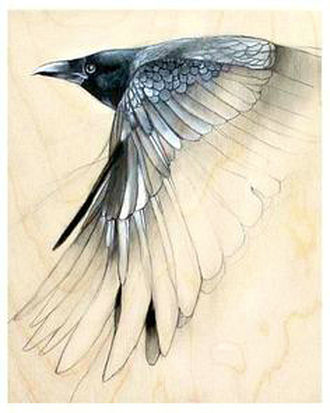
Yup’ik: Raven’s Children
.To remain long-term in a place like Bethel you either have to numb yourself with booze or be a missionary determined to “save” the Eskimos. Nina was neither. (The alcoholism among whites and natives in Alaska is staggering. When Nina interviewed for a pediatrics position in Barrow at the northern tip of Alaska, she informed the town board that her first Rx as a doctor would be to insist that all booze be outlawed in town. Child neglect and abuse from drunken Inupiaq parents were astronomical. Their response was to boot us out — on the next plane south. I fought the boot-legging in Bethel till I realized I would get myself shot by an irate bootlegger. I decided to leave in the passenger seat of an Air Alaska jet instead of a casket.)
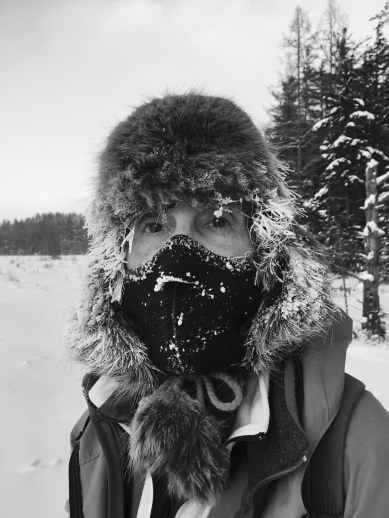
Dr. Nina wearing beaver hat made by an Eskimo woman. This is the only hat that keeps you warm in winter in Alaska. (Photo taken 12/31/17 in Upstate NY, where winter temperatures can rival Alaska tundra temps.)
We drove our Subaru into a large sardine can called a shipping container (the only roads on the tundra are in Bethel — 6 miles of them) and had it barged down the inland passage. Thirty days later we flew to Seattle, retrieved the car, and headed east — to a cabin on Grand Manan in the Bay of Fundy.

Largely for the birds.
.

Shearwater

Kittiwake
.

.
We lived in a cottage 100 feet from the sea. (The above cottage happens to be a short walk from, and nearly identical to, the one we rented.) Nina took long walks along sea bluffs to be with her beloved seabirds. Gannets. Guillemots. Petrels. Shearwaters. Old Squaw. Wintering loons. Puffins. Kittiwakes. Murres. Razorbills. I continued writing “The Way of the Human Being,” which I had started in Alaska. I taught a senior seminar, pro bono, at the local high school. We became part of the community, joining congregants in church Sunday morning to sing hymns for the safe return of island lobstermen & fishermen — prayers that were sometimes denied.

.
The sea giveth and it taketh. Like the tundra.
Our plan was to live here till late fall, then move back to New Jersey for the start of the spring semester, when I was slated to return to teaching at Rutgers.
Alas this didn’t happen. Imagine living in the vast trackless arctic surrounded by some of the calmest and most patient people on earth — then slamming your accelerator to the floor as you roar down the ramp into bumper-to-bumper rush-hour traffic on the NJ Turnpike!
We lasted two days in NJ. Appalled, we fled north to our cottage where all we heard was the rumble of surf, Old Squaws muttering in the dark, and the horn of a distant lighthouse.
I contacted my dept. chairman and resigned. Twenty years ended with a postage stamp and two short paragraphs in an envelope.

We were free! No commitments! No kids! No debts! We could move anywhere in North America — the world for that matter! — and Nina could hang out her shingle. The thought was intoxicating. With a rainy, stormy North Atlantic winter coming on we packed the Subaru and drove to Santa Fe to live in a charming guest apartment owned by Nina’s parents, several miles outside the city.
.
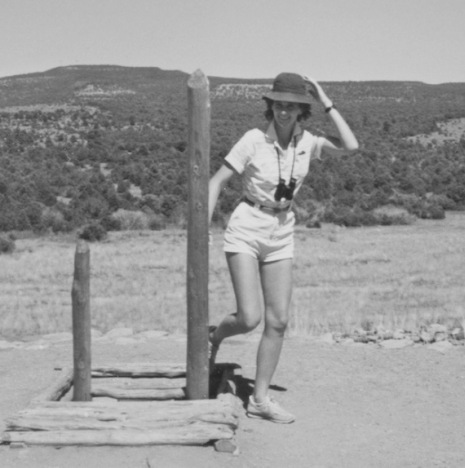
Emerging from a kiva at Pecos Pueblo
.
Sunshine. Immense sky. Sangre de Cristos. High desert. Jackrabbits. Bluebirds. Cross-country & downhill skiing. Pueblo & Navajo culture. Silver & turquoise jewelry. Spanish architecture. Chili so hot it burns your nostrils. Anasazi ruins. Bandelier National Monument. Air rich with the aromatic fragrance of mesquite wood-fires. Plus all the snobbery and pretense that makes Santa Fe oh so special.
.

St Francis Cathedral, Santa Fe
Nina searched for jobs from our new headquarters on Leaping Powder Road. She interviewed on the Navajo reservation: Crown Point (loaded with blowing uranium dust), Fort Defiance (crushingly depressing) and Tuba City (not a good fit). Plus a slick peds office in Santa Fe. (Nina doesn’t do “slick.”) Plus a precious, self-righteous peds practice in Taos. (She doesn’t do “precious” or “self-righteous.”)
.

Red dot above “Adirondack Park” is Malone
In the end the choice came down to a hospital & clinic in northern New Hampshire and a practice on the northern boundary of NY State’s Adirondack Park. We picked the latter.
.

Downtown Malone, “back in the day”
.
Twenty years later, we’re still here. Malone NY calls itself the “Star of the North since 1802.” I’m not sure I’d call it this today. It’s a dying 19th-century milltown. Paper mills, textile mills, shoe mills, long ago boarded up and crumbling. Railroads ripped out. Downtown mostly deserted.
Even so it’s a lovely town. Gorgeous old homes (chiefly Victorian and Federalist). Magnificent river flowing through its center (Salmon River). Good people, mostly of French-Canadian & Irish stock. English-speakers came mainly from Vermont. We’re 1.5 hours from Montreal and Ottawa, 2 hours from Burlington VT and 2 from the Thousand Islands (where my family owned an island). Mature sugar maples line our street. The drinking water flows out of the Adirondacks. We’ve got 4 robust seasons. And 2, 3, 4 feet of snow for cross-country skiing.

Best of all is the Adirondack Park. “Six million acres of forever wild.” Some of the best canoe country in North America.
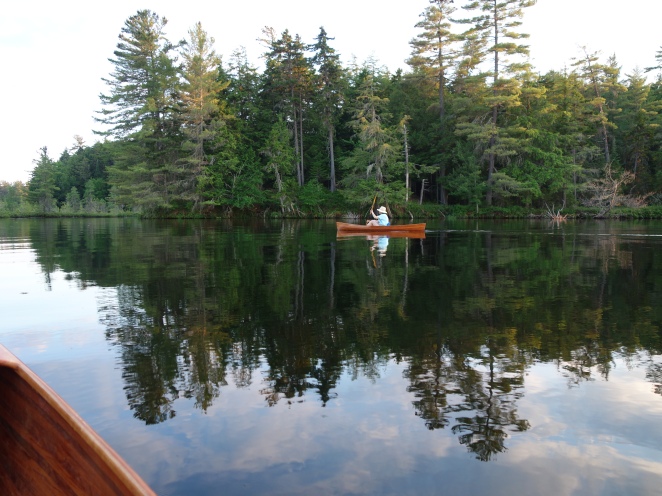 .
.
Unmatched hardwood forests. Beaver. Otter. Mink muskrat fisher bobcat black bear moose deer coyotes wolves. A spring warbler wave. Snow geese migrate down from Canada and stop off in our fields of corn stubble. Loons in virtually every pond.
.

.
Nina, formerly on the Yale swim team, now swims in wilderness ponds. (She will set aside 2 hours during the day to go down and swim, towing her 17-lb Wee Lassie cedarstrip canoe.)

The swimmer & canoeist is also a knitter — gorgeous Fair Isle (Scotland) sweaters.

(Nina didn’t make this Fair Isle sweater, but, yes, sweaters like it.)
And pianist. Four years of lessons on the Schimmel Konzert “Belle Epoque” which dominates our living room. (Bach. Beethoven. Chopin Nocturnes. These are her favorites. She will play a piece several times by reading the music, and then — miraculously! — she’s memorized it. She doesn’t try to memorize it; it just happens. I consider this unfair and a little eerie. It’s certainly not normal. The other evening she was playing a Chopin Nocturne with her eyes closed. This is beyond unfair!)

The living room is a music conservatory for the piano and Nina’s flute.
.
.
In some ways Nina’s like an old-fashioned country doctor. She practices out of our home. (No staff, save for a biller.)
.
.
She limits herself to behavioral pediatrics and adult psychiatry & psychotherapy.
- she makes all her own appointments
- she is the only one answering the phone when people call
- she answers the phone day and night
- she answers the door and brings her patients into her waiting room
- she sees patients for an hour each, with a half hour between appointments
- she sees people till 8 pm, Monday through Friday
- she loves it, though it’s exhausting
.
.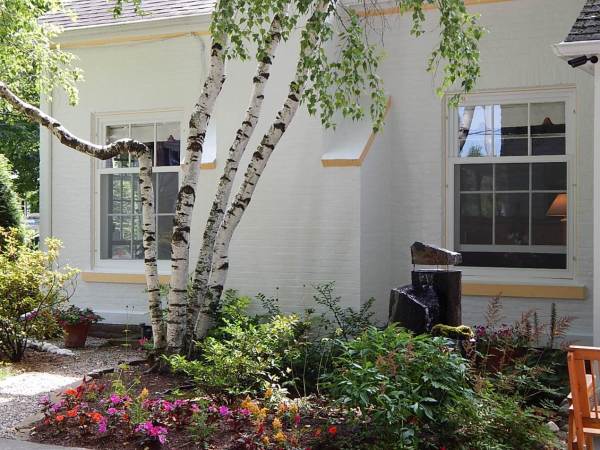
. .
.

Foyer through French doors. Front door to the left, waiting room to the right.
.
Malone is half an hour south of Akwesasne, home to the Mohawk Nation, one of the Five Nations Iroquois. Mohawk call themselves the Keepers of the Eastern Door of the League of the Iroquois. (Picture a traditional Iroquois longhouse, with an eastern door and western door.)

.
For three years Nina was the pediatrician to the Mohawk Nation. When she retired they held a traditional ceremony, giving her handmade baskets and a painting showing the creation of life and the Mohawk clans. The plaque on the painting reads, “Nia:wen! You cared for our children!” (Nia:wen: “Thank you.”)
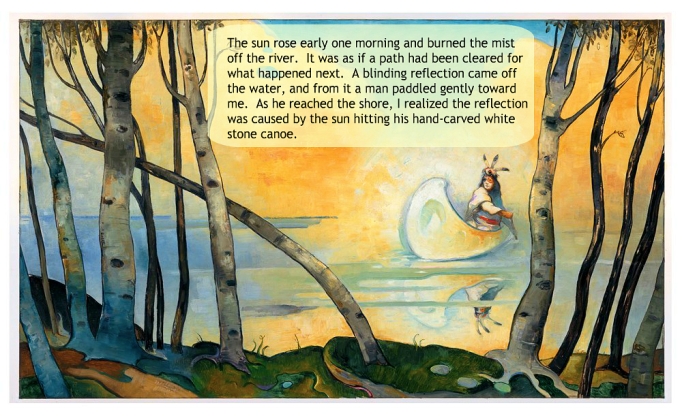
This is a page from a modern-day retelling of the Iroquois “Peacemaker” story of the mysterious sage who crossed L. Ontario in his white stone canoe to bring the Great Peace to the warring Iroquois. It is said that his first convert was the cannibal, Hiawatha. Between them, Peacemaker and Hiawatha went on to found the League of the Haudenosaunee, the Iroquois Confederacy that survives to this day. It is said that Peacemaker will return someday and inspire the People of the Longhouse once more. (See “Hiawatha and the Peacemaker,” by Robbie Robertson & David Shannon.)
.
Although no longer their official pediatrician, Nina continues to treat and heal Mohawk children in her home office
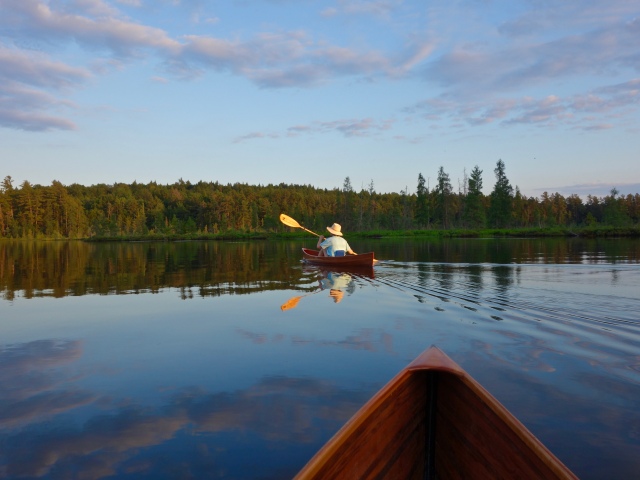 .
.
Perhaps in a way I can’t fathom, she was sent to me by Peacemaker. “A blinding reflection came off the water,” they say, and from it — a woman paddled gently toward me. She healed me.
Nia:wen: You take care of me — Calvin.
.